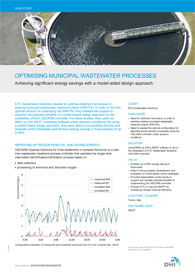 In order to find the optimal solution for revamping their wastewater treatment plants (WWTPs), ETC initiated two studies to examine the potential benefits of a model-based design approach for the installation of their OSCAR® controller. They used our MIKE Powered by DHI WEST modelling software under dynamic conditions for both studies.
In order to find the optimal solution for revamping their wastewater treatment plants (WWTPs), ETC initiated two studies to examine the potential benefits of a model-based design approach for the installation of their OSCAR® controller. They used our MIKE Powered by DHI WEST modelling software under dynamic conditions for both studies.
The first study involved modelling a 10,000 Population Equivalent (PE) WWTP to investigate the predicting capability of the Activated Sludge Model No. 1 (ASM1) for an extended aeration process, which was converted into an OSCAR® installation. ETC set up the bioprocess layout in WEST by taking into account the hydrodynamic behaviour of the tank and the oxygen transfer efficiency of the installed aeration device.
ETC then performed short-term calibration to determine the chemical oxygen demand (COD) fractions in the influent, the autotrophs and heterotrophs biokinetics, and the ammonification rate. The calibrated model was then successfully verified over a 30-day validation period.
Next, the outputs of the WEST model were used as a support tool in the definition of optimal thresholds and set-points of the OSCAR® controller. ETC confirmed a large improvement in performance of the controller with regard to nitrogen removal, energy savings in blowers, and reduced sludge production.
In the second study, ETC examined the possibility of installing the OSCAR® controller for a carrousel process in one of three treatment lanes of a 60,000 PE municipal WWTP. They then compared current performances and the on-off aeration control achievable with the OSCAR® controller by using a typical pattern of influent flow rate, COD, and nitrogen concentration. Introducing properly set anoxic phases increased denitrification efficiency and resulted in a substantial improvement in nitrogen removal.
By using a model-based design approach, ETC WAS able to successfully develop and evaluate control strategies and achieve energy savings in bioprocesses of up to 60%.